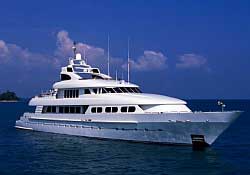Yacht Crewing is that magical mix between large cruise sailing and small ship charm. The open seas, travel and lets not forget some serious hard work. The romanticism of sailing has captured an extreme audience; some stay in it for the long haul, purchasing their own boats and sailing professionally. Others pay the fee and enjoy the boat from a passenger’s perspective fulfilling their sailing dreams and then returning to their everyday lives. Regardless of how or why, yacht sailing has a very intense draw for a wide variety of people. This appeal has translated into an industry that is growing, with jobs that need filling.
Types of Yachts
 Yacht Crewing is very different from working on a cruise ship. The employees onboard are members of a smaller staff, the responsibilities vary, passenger groups are smaller and the places you can travel, different. Because the most distinct difference is size, the passengers onboard and crew can make a really big difference in the type of work environment onboard. The personality of the captain for instance, or the type of travel that specific yacht makes are all factors that can effect an employee’s work experience. These differences exist on larger ships for certain, however with such a small environment these variations are amplified. Knowing a little about the different types of yachts might help to identify the work environments you can expect on each.
Yacht Crewing is very different from working on a cruise ship. The employees onboard are members of a smaller staff, the responsibilities vary, passenger groups are smaller and the places you can travel, different. Because the most distinct difference is size, the passengers onboard and crew can make a really big difference in the type of work environment onboard. The personality of the captain for instance, or the type of travel that specific yacht makes are all factors that can effect an employee’s work experience. These differences exist on larger ships for certain, however with such a small environment these variations are amplified. Knowing a little about the different types of yachts might help to identify the work environments you can expect on each.
Luxury Yachts are rarely seen and then forgotten. Typically gorgeous, and ranging in size, yachts of this kind can include mega yachts and super yachts the sort you hear billionaires own, with ridiculous amenities and ship life that reflects high-end living. Charter Yachts can be equally as nice and are usually paid for by the day or multi-day trip. These types of trips can vary extensively, ranging from tours around a popular bay to month long cruises in exotic oceans. Charter Yachts are owned by a captain, or possibly a company, who charter their boats out for private use. The staff and passengers onboard are small and usually the same crew works for the duration of many chartered cruises. Staff on a chartered yacht can expect long hours and hard work. An employee usually walks away with an extensive knowledge of the boat and a large number of skills to add to his/her resume. Chartered Yachts aren’t always categorized as ‘luxury yachts’ but the living environment of most are fairly high-end with fine dining, luxurious travel locations and a staff that is well mannered.
The Work
What isn’t different from working on a yacht to that of larger ship is the amount of work an employee can expect. The sea is demanding and with a smaller ship, you can’t hide a job un-done nearly as well. The hours are long, but the work rewarding. While an employee might have a specific job title, the work often ends up a collective group effort with everyone doing a little bit of everything. Because of the allure of yacht cruising, some captains take on workers who are so eager to learn, they are allowed to stay onboard for free and work solely for the experience of learning the boat. While this is rare, it is an excellent reflection of how attractive yacht cruising can be, even from a worker’s perspective. The etiquette onboard is usually set at a high standard and among the standard safety and required training, is etiquette training as well. Employees can expect small cabins with little to no, personal space. Maritime rigmarole and ship hierarchy are followed on a yacht in the same way they are on a larger ship and the staff will be expected to be well disciplined and respectful. High standards of cleanliness are almost a religion onboard a yacht and with so many people sharing such a confined space, staff will find themselves doing their fair share of janitorial work.
The work hours and expectations more than pay off for the maritime knowledge learned and experiences so amazing, they can almost not be described. Employees who are willing to deal with high demands are usually rewarded with great memories and unforgettable experiences.

